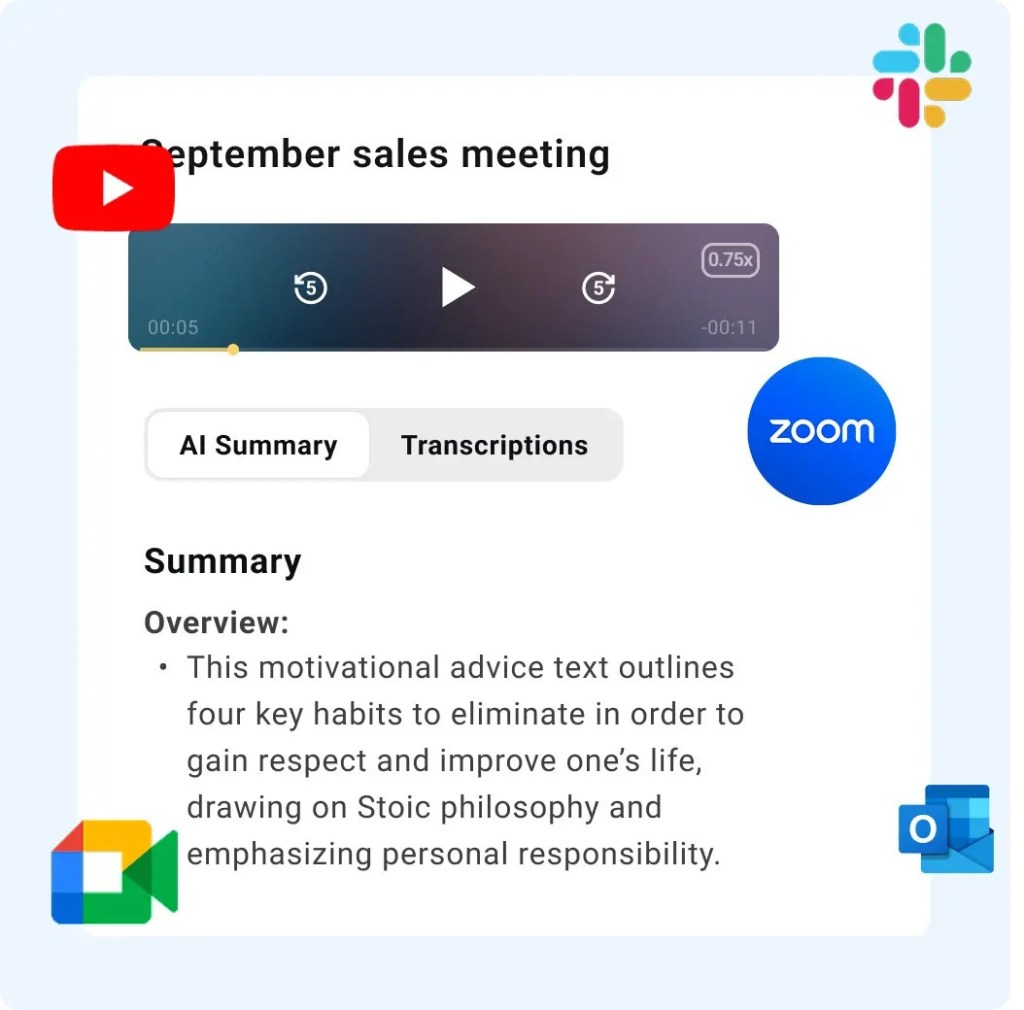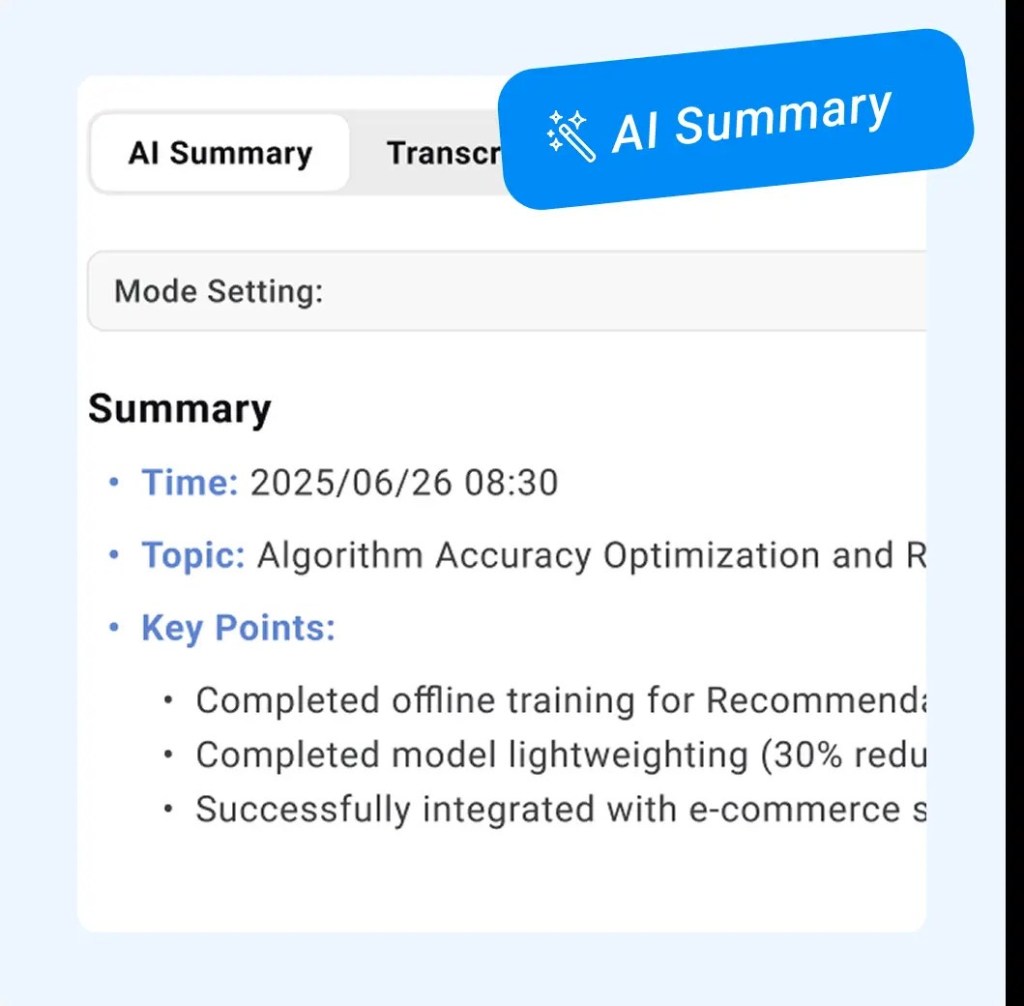Every professional knows the struggle: you’re in an important meeting, trying to absorb complex discussions while frantically scribbling notes, only to realize later that you’ve missed critical details. Studies reveal that professionals spend an average of 5.6 hours weekly in meetings, with nearly 40% of that time lost to ineffective documentation. Manual note-taking not only divides your attention but also produces incomplete records that lead to miscommunication and duplicated work. AI transcription technology has emerged as a transformative solution, converting spoken conversations into accurate, searchable text automatically. This innovation liberates meeting participants to engage fully while ensuring every word, decision, and action item is captured with unprecedented precision. Whether you’re managing client calls, team standups, or board meetings, AI-powered transcription tools eliminate the documentation burden that has plagued meeting-heavy professionals for decades. This article demonstrates how automated transcription delivers flawless meeting records, saves countless hours, and transforms how your organization captures institutional knowledge.
The Costly Burden of Manual Meeting Documentation
Picture Sarah, a project manager juggling three client calls daily, hunched over her laptop trying to type notes while responding to questions. By day’s end, her fragmented records miss half the discussed deliverables, forcing follow-up emails that waste another hour. This scenario plays out millions of times daily across corporate environments. Research from Harvard Business Review indicates that 67% of professionals admit their meeting notes contain significant gaps, leading to misaligned expectations and project delays. The cognitive load of simultaneous listening and writing reduces comprehension by up to 30%, meaning note-takers understand less than passive participants. Beyond individual struggle, organizations face staggering costs when manual transcription becomes necessary—professional transcriptionists charge $1.50 to $3.00 per audio minute, turning a one-hour executive meeting into a $180 expense with 48-hour turnaround times. Companies relying on administrative staff for meeting minutes allocate 15-20 hours weekly to this single task, equivalent to half a full-time position. The accuracy problem compounds these costs: misheard figures, forgotten action items, and subjective interpretations of discussions create downstream confusion that derails projects. When legal or compliance teams require verbatim records, the stakes escalate dramatically. The convergence of these factors—attention fragmentation, accuracy failures, time consumption, and financial drain—makes automation not just convenient but strategically essential for competitive organizations.

Understanding AI Transcription Technology
Modern AI transcription systems operate through sophisticated neural networks trained on millions of hours of human speech, enabling them to transcribe audio to text with accuracy rates exceeding 95% in optimal conditions. Unlike early speech recognition software that required robotic enunciation and struggled with accents, today’s context-aware algorithms analyze entire sentence structures, grammatical patterns, and domain-specific terminology to predict words based on surrounding context. Natural Language Processing (NLP) layers add intelligence beyond mere dictation—these systems identify discussion topics, detect sentiment shifts, and recognize when conversations transition between agenda items. Leading platforms now distinguish between casual brainstorming and actionable decisions, automatically flagging commitments and deadlines. Accuracy benchmarks tell the transformation story: while human transcriptionists achieve 98-99% accuracy but require hours of work, AI systems deliver 90-96% accuracy instantly, with the gap narrowing quarterly as training datasets expand. The speed advantage proves decisive for business applications—a 60-minute meeting produces a searchable transcript within 3-5 minutes compared to the 4-6 hours a professional typist would need. Traditional methods also lack scalability; an organization can’t easily transcribe fifty simultaneous meetings, but cloud-based AI handles unlimited parallel sessions. This technological leap transforms transcription from a labor-intensive bottleneck into an instantaneous utility, fundamentally changing how organizations capture and leverage meeting intelligence.

Essential Features for Professional Meeting Transcription
When evaluating AI transcription solutions for business environments, real-time audio transcription stands as the foundational capability—systems that process speech as it’s spoken enable participants to reference earlier discussion points instantly rather than waiting for post-meeting delivery. This live functionality proves invaluable during lengthy sessions where decisions build upon earlier statements, allowing teams to verify details before the conversation moves forward. Speaker identification, technically called diarization, separates individual voices and labels contributions by participant name, transforming undifferentiated text blocks into structured dialogue that reveals who committed to which action items. Advanced platforms learn voice signatures across recurring meetings, automatically recognizing team members without manual tagging. Custom vocabulary integration addresses the universal frustration of AI systems mangling industry jargon—whether you’re discussing pharmaceutical compounds, legal precedents, or software architecture, the ability to upload specialized terminology ensures technical accuracy that generic models cannot match. The leap from raw transcripts to automated meeting minutes represents perhaps the most significant productivity gain, as intelligent systems extract decisions, action items, and deadlines into formatted summaries without human intervention. For distributed teams, multi-platform compatibility matters enormously—a voice recorder with transcription that works seamlessly across Zoom, Microsoft Teams, Google Meet, and in-person sessions eliminates the friction of switching tools based on meeting format. Security compliance cannot be an afterthought consideration; enterprise-grade solutions must offer end-to-end encryption, SOC 2 certification, GDPR adherence, and data residency options that satisfy legal and IT requirements. Organizations handling sensitive client information or proprietary discussions need platforms with access controls, audit trails, and the ability to automatically redact confidential information before sharing transcripts externally.
Step-by-Step Implementation for Flawless Documentation
Pre-Meeting Preparation
Successful transcription begins before anyone joins the call. Start by selecting a tool that matches your specific meeting environment—if your organization lives in Microsoft Teams, choose a solution with native integration rather than forcing workarounds with standalone recorders. Dedicate fifteen minutes to building a custom glossary containing your team’s frequently used terms: product names, client identifiers, technical acronyms, and industry-specific vocabulary that generic AI models typically mangle. Upload this terminology database to your transcription platform so the system recognizes “Kubernetes” instead of transcribing “communities” or correctly captures your client “Vanguard Logistics” rather than “vanguard the logistics.” Connect your transcription tool directly to your calendar system so it automatically joins scheduled video conferences without manual intervention, eliminating the common failure point where someone forgets to activate recording. Test audio input levels beforehand, especially for in-person meetings where room acoustics and microphone placement dramatically affect accuracy—position recording devices centrally, away from air conditioning vents and projector fans that introduce background noise.
During the Meeting
Once the meeting begins, verify that transcription has initiated by checking for the live text feed within the first thirty seconds, catching technical failures before valuable discussion passes unrecorded. Encourage participants to state their names when first speaking if the system hasn’t encountered their voices previously, which trains speaker identification for future sessions. Minimize cross-talk and interruptions not just for courtesy but for transcription accuracy—AI struggles when multiple voices overlap, producing garbled text that requires extensive post-meeting correction. When discussing critical figures, dates, or commitments, speak them clearly and consider briefly pausing afterward, giving the algorithm processing time to contextualize important data points. If someone shares complex information like email addresses or product codes, type them in the chat as backup since even advanced systems stumble over alphanumeric strings spoken aloud. Monitor the real-time transcript periodically for major errors, particularly when conversations shift to new topics where context clues haven’t yet established meaning—catching a misunderstood client name during the meeting takes five seconds versus five minutes of post-meeting detective work.
Post-Meeting Processing
Immediately after the meeting concludes, export the raw transcript before making edits, preserving an unaltered record for compliance or dispute resolution scenarios. Review the automated summary that intelligent platforms generate, which typically highlights detected action items, decisions, and key discussion points—this AI-generated overview handles 80% of traditional minute-taking work, requiring only verification rather than creation from scratch. Focus your editing efforts on the 5-10% of content that matters most: decision points, assigned tasks, and commitments with deadlines, rather than perfecting every conversational filler word in hour-long discussions. Use your platform’s search functionality to quickly locate specific topics or speaker contributions instead of reading transcripts linearly, drastically reducing review time. Create a distribution protocol that matches sensitivity levels—perhaps full transcripts go only to direct participants while sanitized summaries reach broader stakeholders, and searchable archives land in your knowledge management system with appropriate access controls. Establish a same-day turnaround standard where meeting summaries reach participants’ inboxes within four hours, capitalizing on fresh memory to catch any AI misinterpretations while context remains clear.
Top AI Tools for Automated Meeting Minutes
The transcription landscape offers distinct solutions tailored to different organizational needs and budgets. Enterprise-focused platforms like Otter.ai have become synonymous with professional meeting transcription, offering robust speaker identification across unlimited participants, real-time collaboration features where team members annotate live transcripts simultaneously, and native integrations with Zoom, Teams, and Google Meet that require zero technical setup. Their advanced AI generates automated meeting minutes that categorize discussion by topic and extract action items with assigned owners, though premium tiers reaching $30 per user monthly position it as a serious business investment. Fireflies.ai distinguishes itself through conversation intelligence features that analyze meeting sentiment, track talk-time ratios, and surface recurring themes across meeting series—particularly valuable for sales teams reviewing client call patterns or managers identifying communication bottlenecks. For organizations prioritizing data sovereignty, Tactiq operates as a browser extension that processes transcription locally rather than uploading audio to external servers, addressing security concerns that prevent many legal and healthcare organizations from adopting cloud-based solutions. Budget-conscious teams find capable alternatives in Notta and Riverside, which deliver accurate transcription and basic speaker identification at $10-15 monthly price points, sacrificing advanced analytics but maintaining the core functionality that eliminates manual note-taking. Emerging platforms like Owll AI are also entering the space with streamlined approaches to meeting documentation that emphasize ease of use alongside transcription accuracy. Mobile-first professionals benefit from dedicated voice recorder apps with transcription like Rev Voice Recorder and Noted, which capture in-person meetings through smartphone microphones and deliver transcripts within minutes, though they typically lack the meeting intelligence features of full platforms. The critical selection factor isn’t identifying the “best” tool universally but matching capabilities to your specific workflow—a ten-person startup needs different functionality than a regulated enterprise with compliance requirements.
Transform Your Meeting Documentation Today
The transformation from frantic manual note-taking to AI-driven documentation represents more than technological convenience—it fundamentally reshapes how organizations capture and leverage meeting intelligence. By eliminating the attention split between listening and writing, AI transcription tools restore meetings to their intended purpose: collaborative thinking and decision-making rather than administrative scrambling. The precision gains speak for themselves: 95%+ accuracy rates, instant searchability, and automated extraction of action items deliver meeting records that manual methods simply cannot match, regardless of how diligent the note-taker. Time savings compound across organizations—those 15-20 weekly hours previously consumed by documentation now redirect toward strategic work that actually moves business objectives forward. The technology has matured beyond early adopter experimentation into production-ready solutions trusted by enterprises handling sensitive discussions. Start your transition today by testing one of the platforms discussed here with a single recurring meeting, experiencing firsthand how complete transcripts change follow-up clarity and accountability. As AI capabilities continue advancing, automated meeting minutes will evolve from optional productivity enhancement to standard operational infrastructure, making early adopters the organizations that capture institutional knowledge others lose forever in forgotten conversations.














